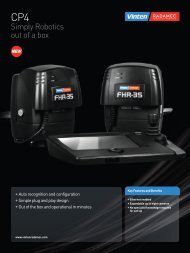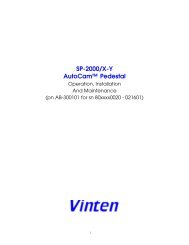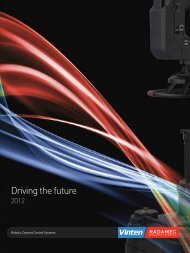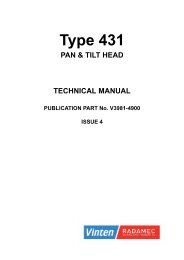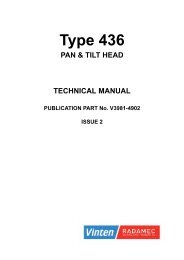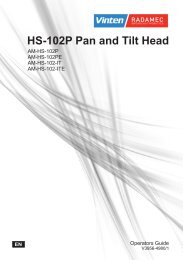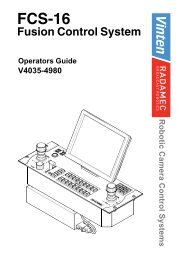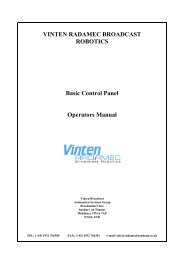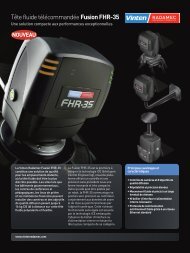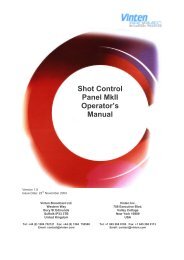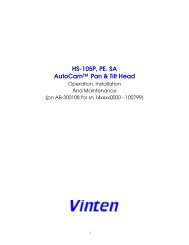Robotic and Manual Pan & Tilt Head - Vinten Radamec
Robotic and Manual Pan & Tilt Head - Vinten Radamec
Robotic and Manual Pan & Tilt Head - Vinten Radamec
Create successful ePaper yourself
Turn your PDF publications into a flip-book with our unique Google optimized e-Paper software.
Setting fore <strong>and</strong> aft balance<br />
When positioning the payload it is important to be aware of the potential danger of an unbalanced payload<br />
falling away suddenly. Always be prepared for this by maintaining a firm hold on the payload until the balance<br />
has been set correctly.<br />
To set the fore <strong>and</strong> aft balance:<br />
1. Hold <strong>and</strong> steady the camera cradle, <strong>and</strong> disengage the tilt lock (see Locking the camera cradle).<br />
Carefully release the camera cradle <strong>and</strong> observe how it moves <strong>and</strong> comes to rest.<br />
2. If the camera cradle tilts forward (points downwards) then the camera must be moved towards the rear<br />
of the <strong>Head</strong>.<br />
3. If the camera cradle tilts backwards (points upward) then the camera must be moved towards the front<br />
of the head.<br />
4. Reposition the camera as required on the camera cradle <strong>and</strong> secure in position. The horizontal balance<br />
is correct when the camera cradle comes to rest in a horizontal position.<br />
5. If there is insufficient movement within the camera cradle slots to achieve horizontal balance, reposition<br />
the mounting plate (supplied with the camera) on the camera as required, <strong>and</strong> re-fit to the camera cradle.<br />
6. If a teleprompter is attached to the mounting holes, it may be necessary to attach counter balance<br />
weights to the teleprompter extension arms.<br />
Centre of Gravity height adjustment<br />
Fore <strong>and</strong> aft balance must be set before adjusting the payload centre of gravity (C of G) vertically to the tilt axis.<br />
To set the centre of gravity height adjustment:<br />
1. Switch OFF power to the <strong>Head</strong> <strong>and</strong> engage the tilt lock.<br />
2. Loosen the three screws securing the camera cradle to the tilt drive, <strong>and</strong> raise the camera cradle to<br />
vertically align the camera assembly centre of gravity with the tilt axis.<br />
3. Tighten the three screws to secure the camera cradle into position.<br />
4. Select <strong>Robotic</strong> mode by rotating the tilt robotic/manual mode rotary switch fully counter-clockwise.<br />
5. Disengage the tilt lock.<br />
6. <strong>Tilt</strong> the camera cradle through positive <strong>and</strong> negative angles of travel, checking that the <strong>Head</strong> remains at<br />
any angle of tilt unsupported.<br />
7. If the camera cradle angle tends to fall toward horizontal when unsupported, then raise the camera<br />
cradle. If the camera cradle angle tends to rise toward vertical when unsupported, then lower the camera<br />
cradle. Re-position <strong>and</strong> secure the camera cradle vertically as required until balance is achieved.<br />
8. After adjusting the centre of gravity height, it may be necessary to check that the fore <strong>and</strong> aft balance<br />
remains satisfactory. Re-adjust the position of the camera horizontally on the camera cradle as required.<br />
8<br />
Note: Depending on the camera configuration, it may be necessary to use an Intermediate Plate<br />
(Part No. 3384-11) to raise the centre of gravity sufficiently to align with the tilt axis (see Balancing<br />
the <strong>Head</strong> <strong>and</strong> payload on page 7).



